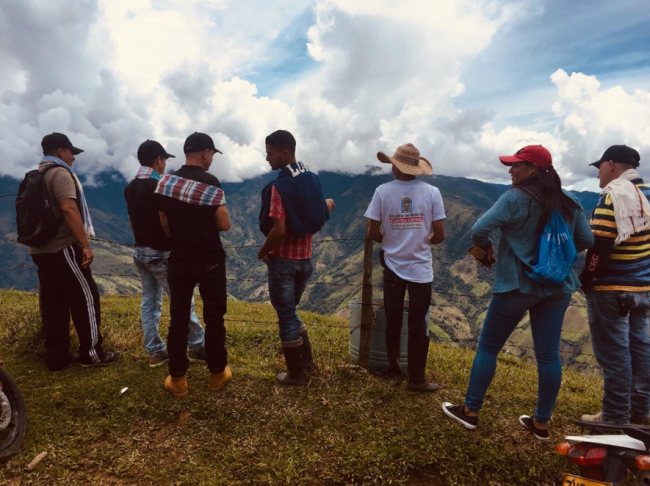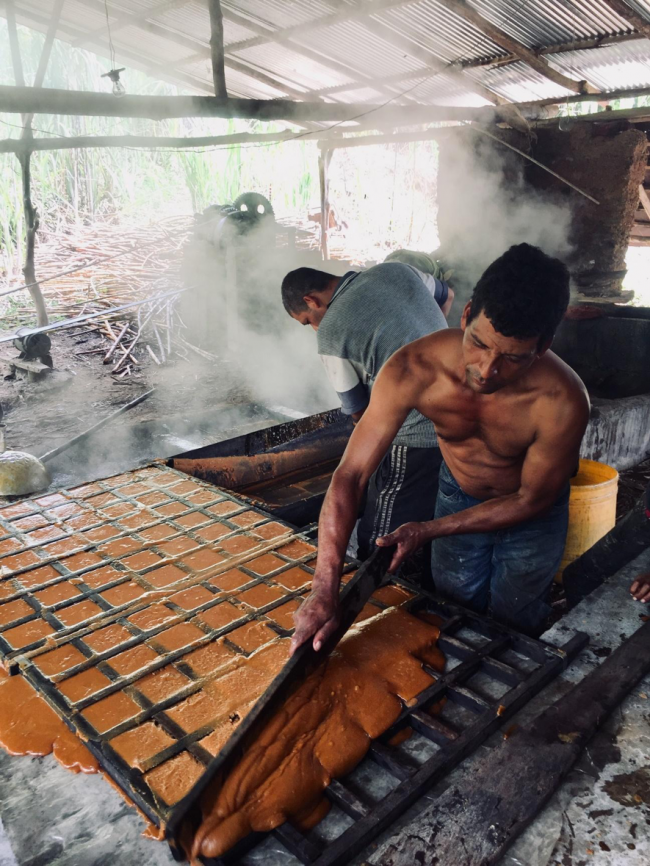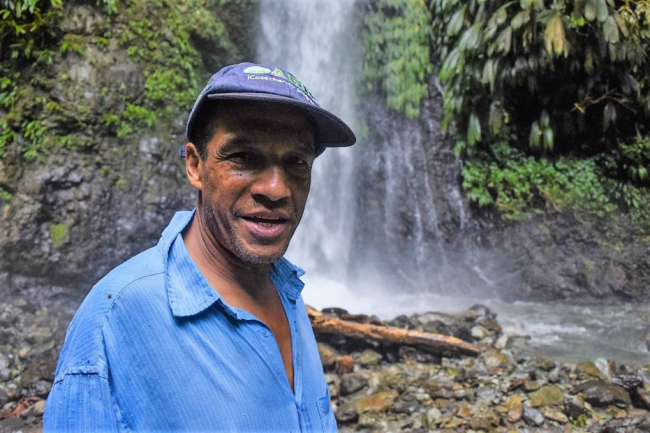
NACLA is launching a summer fundraising campaign. Click here to show your support.
Haz clic aquí para leer la versión en español.
El Orejón, an isolated rural community in the northern Colombian department of Antioquia, is slowly emptying out. A few years ago, 88 people lived on family farms on the valley walls above the Cauca river. Only 48 remain. The neatly cultivated plots of corn, beans, coffee, sugar cane, and yuca of the families still there stand out from the abandoned lands that the jungle is gradually reclaiming. But in contrast to the classic model of rural communities abandoned by the state, the Colombian government has invested significantly in El Orejón, a crucial area for Colombia’s peace process.
El Orejón was the site for the 2015 demining program that marked the first collaboration between the Colombian government and the Revolutionary Armed Forces of Colombia (FARC), before being chosen during negotiations of the peace accord as one of 11 hamlets in the municipality of Briceño to launch the pilot coca substitution program in 2017. Little more than two years ago, coca plants covered the hillsides above the river. Now the plants are gone, pulled out voluntarily by local campesinos seeking a transition to legal agriculture.
As El Orejón declines, a settlement across the river, complete with tennis courts and swimming pools, has emerged in the last ten years. This is the camp for workers who are constructing Hidroituango, the largest hydroelectric dam project in the history of Colombia, which lies directly below El Orejón. Public Enterprises of Medellín (EPM), the public-private partnership that is building Hidroituango, has recently come under fire for illegal and irresponsible construction practices with disastrous consequences. In May 2018, a tunnel built to divert river waters during the construction blocked up for weeks and then subsequently burst, leading to massive flooding that displaced 25,000 people in downstream communities.
But the displacement in El Orejón and other communities near the project has nothing to do with flooding or engineering mistakes. Instead, these communities speak to a deeper and less discussed aspect of the Hidroituango project: the way it has disrupted local livelihoods, primarily by limiting their access to the river. This exclusion goes hand in hand with coca substitution and the peace process. Together, they comprise a broader process of pacification in the region that at first deployed violence, and now peace, to serve elite interests at the expense of campesino ways of life.
Campesino Livelihoods—and their Disappearance
The people of El Orejón say the Cauca River was their patron. It offered them fish, sand for use in construction projects, fertile earth, and most importantly, the opportunity to pan for gold—a guaranteed source of income in an impoverished region. When they needed money, they went down to the river, often staying for days at a time in hastily constructed huts, eating freshly caught fish and sifting through the silt on the riverbanks in search of gold nuggets. Gold panning also sustained other economic activity, including women who sold food to the gold panners, and arrieros—men who transported groceries and fish to and from the riverbank encampments.
To construct the dam, EPM needed the riverbanks permanently free. Legally, the company was required to compensate those who depended on the river for their sustenance—essentially the entire community of El Orejón. In 2008, EPM conducted a census of affected families to determine who was eligible for compensation. However, it announced its census on the same (and only) day it conducted the census. Moreover, it did the census in only two areas, each more than two hours from El Orejón on mule paths. Those who were working on the beaches—areas without a cell phone signal—were even farther away from the census points. Locals say EPM made no attempt to include them.
Out of the 30 families in El Orejón, all of whom should have received indemnifications, only nine were able to register themselves. The others received nothing. Though EPM only began removing people from the riverbanks when dam construction began in 2011, the company never offered another opportunity for people to register themselves for the indemnification. In the words of Wilder*, a campesino born and raised in El Orejón who had panned for gold in the river for more than thirty years: “They trampled us however they wanted to... I can’t thank EPM for treating me to a soda or a candy to suck on. They took away our rights totally by force.”
While gold panning had existed in El Orejón for as long as locals could remember, coca cultivation only began in 2000, reaching its height after 2013 when locals had completely lost access to the riverbanks. Unlike traditional agricultural products, which are heavy and expensive to transport, coca base—a crude extract of coca leaf in rock form that is an intermediate stage in the production of cocaine—was easily commercialized. Buyers organized by the FARC, the leftist armed group that controlled the region and used taxes on cocaine production to fund their insurrection, arrived near locals’ farms to buy coca base by the kilo. Like gold panning, coca offered a variety of income opportunities: young men picked the coca and were paid by weight, women cooked for the workers, químicos (chemists) traveled to farms to mix coca leaves with chemicals to convert it into rocks of coca base, and property owners rented their land for coca in exchange for 10 percent of the harvest.
Aside from its economic benefits, coca had major disadvantages: locals cultivated it with a noxious mix of chemicals that caused dizziness, nosebleeds, swelling, and even impotence. Additionally, coca brought violence and armed groups to the community, particularly paramilitaries who arrived to compete with the FARC for territorial control. As a result, the people of Briceño enthusiastically embraced their selection as the site of the pilot coca substitution program negotiated in the peace accords. The program offered a year’s worth of subsidies to sustain participants while they implemented three levels of productive projects designed to allow them to transition to legal agricultural activity.
After the substitution program began in June 2017, participants voluntarily uprooted all their coca, began receiving the subsidy payments, and waited for the replacement projects. Goods for the first and smallest level of projects, designed to promote subsistence farms, were supposed to arrive in two months. Instead, they arrived after a year and two months. More than two years after pulling out their coca plants—and more than a year since subsidy payments ended—only a small minority of families have received the second level of short-term projects, which were supposed to be generating profits within the first year. The result across all of Briceño has been economic collapse. While the peace process in Briceño drove an initial investment in rural integral reform programs that led to concrete improvements in local roads and schools, they have failed to generate the infrastructure needed to support a licit economy to replace the coca. Moreover, these programs have ground to a halt since the June 2018 election of right-wing President Iván Duque, which in Briceño led to the disappearance of state functionaries entrusted with implementing rural development programs. While in other areas people have replanted coca, in El Orejón this has yet to happen. Instead, without gold panning, coca, or the promised productive projects and rural reform, many families have left entirely.

Megaprojects in Violence and Peace
In the words of Luis, a 73 year-old man from El Orejón, locals long viewed the FARC, operating in Briceño since 1981, as “a useful group…the presence of the law in the face of state absence.” In areas that had never seen police or government officials, the FARC organized communal work groups to fix local paths, imposed a minimum wage, resolved domestic disputes, and punished criminals. The dynamics of FARC presence in the area changed in the late 1990s to 2003, when right-wing paramilitary groups entered the region in force. Campesinos were caught in the middle of heavy fighting, with many killed or displaced, including 15 massacres of civilians in the municipalities surrounding Hidroituango between 1996 and 1998. Government officials like ex-Colombian President Alvaro Uribe have been linked to many of these massacres; Uribe, as then-Governor of Antioquia, was simultaneously overseeing the creation of Hidroituango project.
Locals understood the paramilitary incursion as a way to, according to Jorge, another man from the community, “clear out the canyon, to allow the (Hidroituango) project to enter where before it couldn’t because of the guerrillas.” The violence pushed the FARC rebels up the valley walls away from the dam site, while also pushing many campesinos out of the region and driving down the prices of the land EPM needed to acquire to move the project forward. The military followed on the heels of the paramilitary incursion, installing troops in 2007 to defend the project from FARC attacks and push the guerrillas even farther away. The guerrillas responded by laying down landmines to forestall the military advance.
In 2015, with the FARC deep in peace negotiations with the government, the two sides agreed to collaborate on a demining program, choosing El Orejón, known as the most-heavily mined area of Colombia, as the first site. The community participated in the program, providing valuable information on the potential location of landmines. However, even though the program was operational until 2018, it never demined the areas that most affected the local community. “We said in a meeting that we would like them to begin at the partida of El Orejón (a strategic and heavily mined point that allows access to many neighboring communities),” said Angélica Mazo, who worked as a cook for the demining program. “And the partida of El Orejón was never demined.”
Instead, the program targeted lower and less-transited areas that were owned by EPM. According to Fabio Muñoz, a member of the community who organized against the dam: “They decided to demine in areas that we had said (contained landmines), but … that were lands that Hidroituango had bought, lands we barely used at all… The demining program was for Hidroituango, not for the community.” Though initially excited about the prospect of ridding their community of landmines, many locals felt that they were merely used for publicity and a program ultimately directed to supporting the hydroelectric dam.
Feeling that the project was trampling their interests, locals in El Orejón and neighboring communities developed Ríos Vivos (Living Rivers), a social movement in opposition to the dam. It gained prominence in 2013, when 400 campesino activists marched more than a week to Medellin and installed themselves in the coliseum of the University of Antioquia to bring public attention to the project’s assault on the environment and local livelihoods. In the eight months they stayed in Medellín, Ríos Vivos held daily public demonstrations and organized different committees to speak with the press, search for food, and even control entry to the university, limiting after-hours access to those who had movement-issued identification cards. As night fell, before each family retired to their tent on the combination basketball-soccer court, they shared their stories—heartbreakingly similar tales of friends and family murdered or disappeared by armed groups.
Muñoz, who lived in the coliseum for eight months along with other Ríos Vivos activists, said that hearing these stories allowed him to understand how everything that had happened in El Orejón was part of a larger strategy by the government and elite interests to depopulate the territory to clear the way for Hidroituango. As Muñoz said, “vacating the region is an immense advantage for them, because they save indemnifications, they save all the problems of being sued, and most importantly, they save having people protest.”
While Ríos Vivos and activists like Muñoz have continued their resistance in the intervening years, it has come at a cost. Not surprisingly, in the most dangerous country in the world to be a social leader, five members of the movement have been murdered, with countless more threatened. Although a technical committee is currently evaluating the environmental impact and stability of the project—and the risk of another disaster like the May 2018 flooding still looms, with EPM having already invested nearly $4 billion in Hidroituango it is impossible to imagine the project being stopped.
In the meantime, while locals are no longer displaced by violence in El Orejón, economic necessity forces many to abandon the region. Most families arrive to the closest major city of Medellín and surrounding areas, where they settle in the peripheral areas they can afford. Currently, 14 people who less than three years ago lived in El Orejón are now living in poor neighborhoods in the Medellín suburb of Bello—areas where armed groups reign and the recently resettled parents said the constant threat of violence meant they didn’t allow their children to leave the house after 6 PM.

The Future for Briceño and Rural Colombia
The community of El Orejón is still organizing, demanding that Hidroituango properly compensate them. They also continue to wait for the productive projects from the coca substitution program. In the meantime, they seek ways to survive economically by selling coffee, chocolate, panela (unrefined cane sugar), and other agricultural products. But El Orejón’s isolation makes many crops that grow in the region like plantains, yuca, and corn prohibitively expensive to transport to points of sale. Even goods like high quality coffee—the same coffee that may arrive to consumers costing upwards of $10 a pound—are subject to the whims of the market and currently fetch less than $1 a pound. Traditional agricultural ways of life are hard to maintain without the extra income of gold or coca, or the kind of rural reform promised in the peace accords that could help make licit crops a more realistic and profitable option.
Most disturbingly for Briceño, however, yet another megaproject is threatening the region’s way of life. Though historically unable to operate because of FARC’s presence in the region, Canadian mining company Continental Gold has owned mining concessions in Briceño for years. After the FARC’s disarmament, the company immediately sent representatives to Briceño to test the soil and convince the community of the money and development a large-scale gold mine would bring. One of the mine’s proposed areas of development is directly above El Orejón. Locals understand that planned drilling to access gold veins would destroy the local ecosystem and threaten their water supply. While generally opposed to the project, they feel they will be unable to stop it through institutional means. Fernando, a member of Ríos Vivos from another part of Briceño, compared the movement’s potential to stop the new mining project with the inability to stop Hidroituango: “There’s no chance that they leave us like we were before. (Countering) large-scale mining is like the fight of an ant against an elephant.”
While the community pursues peaceful means to stop the project, a FARC dissident guerrilla group—which emerged in the area following the government’s failure to live up to the peace agreement—has taken matters into its own hands. Following repeated threats to Continental Gold and its functionaries in September 2018, the guerrillas killed three geologists along the border of Briceño who were working for the Canadian multinational. After the tragedy, the company withdrew from the region completely, which, aside from temporarily halting the mining project, has two consequences. First, it promotes a return to armed group control, offering legitimacy to the guerrillas who demonstrated their power to defend the community from mining projects. This legitimacy gains particular strength when opposed to the campesinos’ exclusion from decision-making processes by the Colombian state, whose Constitutional Court has recently eliminated laws allowing communities to vote on mining and other extractive projects. And second, it has the potential to lead to further conflict. Continental Gold’s other mining project, just west of Briceño in Buriticá, has been linked to paramilitary violence that caused massive displacement and allowed the company to take over abandoned lands. The fear in the community is that paramilitaries, who paved the way for Hidroituango and the Buriticá project, may similarly enter Briceño to expel the guerrilla force and enable large-scale gold mining. Paramilitary groups are already well-established in surrounding municipalities, and rumors are circulating among locals of a growing paramilitary presence in Briceño itself.
As the site of the first demining and coca substitution programs, Briceño became known as Colombia’s Peace Laboratory. State investment in the region was supposed to provide an example of how the peace accords would address the extreme rural poverty and inequality which have constituted the fundamental root of Colombia’s conflict for more than a half century. The story of its pacification at the service of elite-centered development, however, illuminates some of the fundamental contradictions at the heart of Colombia’s peace process. President Iván Duque, who has stalled or dismantled crucial parts of the peace process since his election in 2018, released his National Development Plan in May 2019, focusing on extractive mining and energy projects as the motor of the economy. But even the previous administration under President Juan Manuel Santos, who won the Nobel Peace Prize for negotiating the peace agreement, counted on large-scale mining and energy projects to finance the peace process.
The empty houses of El Orejón bear witness to the fact that this orientation toward megaprojects like Hidroituango is directly opposed to the investment in rural communities that was promised by the peace accords—support that is sorely needed to mitigate poverty and conflict in rural Colombia.
Alex Diamond is a Ph.D. student in Sociology at the University of Texas at Austin. His research focuses on the implementation of the peace accords between the FARC and the Colombian government and the local experience of the peace process in areas previously under insurgent control.
Video by Oscar Osorio, Luis Gallego, and Alex Diamond.
*Use of first names reflects pseudonyms used at sources’ request

